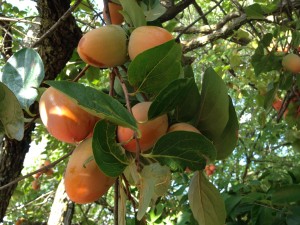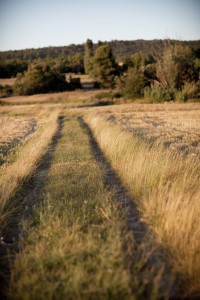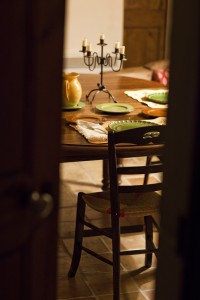Persimmons and Houses in France

Persimmons
In Quinson, not far from my house in Provence, on the road to the Gorges du Verdon, there is a persimmon tree that I have watched for more than 30 years. It is now huge. By November, its orange fruit is brilliant against a landscape of brown, turned earth and barren grape vines. I’ve always admired the tree and thought it so beautiful. This morning, as I looked at my own two persimmon trees here in California, rising above the peak of my house, I realized that they are almost as big as the Quinson tree and that they are 20 years old and as beautiful as the one I have so long admired from afar.
But what to do with persimmons besides admire them? First, it depends what kind of persimmons you have. The round, flattish Fuyu are sweet and crisp and can be eaten like an apple. They can be chopped and used to garnish goat-cheese and thyme spread toasts or added to salads. Try persimmons and toasted walnuts added to an escarole salad dressed with walnut oil and balsamic vinegar, for example. Fuyus also lend themselves to grilling and sautéing and make a sweet-savory side dish. If you have the pointed Hachiya types, don’t bite into them until they are so soft that they are squishy. If you like super soft fruit, this is for you. The Hachiya freeze well and these are the ones to use for baking. My personal favorites for these fruits are Persimmon Flan and Meyer Lemon Glazed Persimmon Bars.
Persimmon Flan
This is one of those recipes that is just too good not to resurrect. I first created it for my book Potager, which is now out of print, then used it again in the Davis Farmers Market Cookbook, which I co-authored with Ann M. Evans. The final flan, made with the jellylike pulp of the burnt orange–colored Hachiya persimmon, has one layer of dense persimmon that sinks into the caramelized sugar and one layer of sweet custard.
1 cup sugar
2 or 3 very ripe, soft Hachiya persimmons, peeled, seeded, and cut into 11/2-inch pieces
2 cups heavy cream
1 cup whole milk
6 eggs
1/2 teaspoon fine sea salt
1 teaspoon vanilla extract
Spread 1/2 cup of the sugar in an 8-inch metal pie pan and place it over medium heat. Holding the edge of the pan with a hot pad, tilt the pan from side to side as the sugar melts and caramelizes so that the bottom as well as the sides is coated with the syrup. When all of the sugar has melted into a golden to dark brown liquid, remove the pan from the stove. Set aside.
In a saucepan over medium-high heat, cook the persimmon pieces, stirring often to prevent sticking or burning, until they release some of their moisture and thicken a bit, about 5 minutes. Remove from the heat and let cool slightly.
Transfer the persimmons to a blender and purée until smooth. Pass the purée though a chinois or a fine-mesh sieve. You should have about 3/4 cup purée.
Preheat the oven to 325ºF. Fill a teakettle with water and bring the water to a boil.
In a saucepan over medium heat, combine the cream and milk and heat until small bubbles form around the edges of the pan. Remove from the heat. In a large bowl, whisk the eggs just until blended, then add the remaining 1/2 cup sugar, the salt, and the vanilla and whisk until thoroughly combined. Slowly pour the hot milk-cream mixture into the eggs while whisking or stirring continuously. Stir in the puréed fruit.
Place the caramel-lined pie pan in a shallow roasting pan just large enough to hold it. Pour the custard mixture into the pie pan, filling it to the rim. Pour the boiling water into the roasting pan to reach halfway up the sides of the pie pan, then put into the oven.
Bake the flan until a knife inserted into the middle comes out clean, 35 to 45 minutes.
Remove the roasting pan from the oven, then remove the flan from the roasting pan. Let cool to room temperature. At this point, the flan can be refrigerated for up to several hours.
To unmold the flan, slide a knife blade or thin metal spatula around the inside edge of the pan to loosen the flan sides. Invert a shallow serving plate on top of the pan and, holding the pan and the plate firmly together, flip them. Lift off the flan pan. To serve, cut into wedges.
Serves 8 to 10
There’s something about France
It’s finally a fall day here in Northern California. It rained last night and into this morning and the air is cool and moist with a hint of damp earth and a sense of possibility. It smells just like the first days of my life in Provence. I stood on the grassy knoll in front of the farmhouse in the Haute Var that we had just bought and looked across the narrow valley below, across to the forest and in the distance the beginning of the Alps.  The crisp fall air carried the smell of burning leaves and the distant clink of bells from the neighboring sheep. Everything seemed peaceful and simple and life full of possibilities. I learned, of course, over many years that peaceful and simple aren’t always what they appear, but the sense and thrill of possibility remains, always made more vibrant by that first cool scent of fall.
The crisp fall air carried the smell of burning leaves and the distant clink of bells from the neighboring sheep. Everything seemed peaceful and simple and life full of possibilities. I learned, of course, over many years that peaceful and simple aren’t always what they appear, but the sense and thrill of possibility remains, always made more vibrant by that first cool scent of fall.
Houses in France
Robert Cohen, in a recent Op-ed piece for the New York Times, Truths of a French Village, tells his readers that he wanted to sell the house he bought in a French village 20 years ago. He called a real estate agent and she came to meet him at the house. Here is what she said to him:
“You cannot sell it. This is a family home. You know it the moment you step in. You sense it in the walls. You breathe it in every room. You feel it in your bones. This is a house you must keep for your children.”
Cohen continues with the story and in so doing comes to the heart of why France is different and why those of us who love it do so. I encourage you to read it:
http://www.nytimes.com/2014/09/23/opinion/roger-cohen-truths-of-a-french-village.html?_r=0
My house in Provence is modest.
It part of an old mas or farmhouse, rising to 3 stories, that was divided, over the years into several living quarters, plus barns, lofts, out buildings, vegetable gardens, and what was once a threshing ground. The building pre-dates the French Revolution, I’ve been told, and has been added onto again and again over the centuries. Seen from the valley below, it looms like a guardian fortress.
I love the smell of its waxed red tiles, my familiar kitchen with all its accoutrements – mortar and pestle, glassed cabinet with dishes from my grandmother and mother and those I’ve collected, plus a fireplace and comfy red and white couch. In my bedroom upstairs the trunk is full of photo albums, special baby clothes I saved, and mementos from a previous life – even old prom dresses.
My son brought his wife there for the first time this year, getting her pastries from the local bakery for breakfast, eating pâté and cheese for lunch on the porch, and going to dinner with friends who remember him as a little boy. He calls it his childhood home and I think he would agree with Cohen’s French real estate agent that it is a house to keep for your children – and their children.


